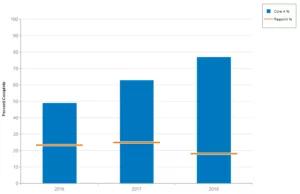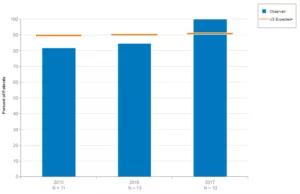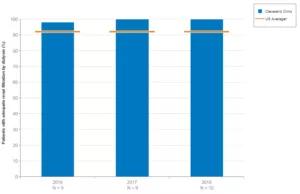Our specialty outcomes speak for themselves

Cleveland Clinic Children’s is proud to be ranked as a national leader in clinical care by U.S. News & World Report in its 2019-2020 edition of “Best Children’s Hospitals.”
Advertisement
Cleveland Clinic is a non-profit academic medical center. Advertising on our site helps support our mission. We do not endorse non-Cleveland Clinic products or services. Policy
According to U.S. News, the rankings score the top 50 children’s hospitals based on clinical data and an annual survey of pediatric specialists. The rankings methodology factors in patient outcomes, such as mortality and infection rates, as well as clinical resources and compliance with best practices. To mark the continued achievement of Cleveland Clinic Children’s, this post focuses on outcomes measures in each of the ranked specialties.
“It is our belief that ALL children deserve not only safe, but the highest quality care available,” states Karen Murray, MD, Physician-in-Chief of Cleveland Clinic Children’s and President of Cleveland Clinic Children’s Hospital for Rehabilitation. “When 2019 medical advancements do not mean cure, Cleveland Clinic Children’s is leading innovation to advance the options so that cure is eventually possible for all children with medical needs, from the common to the most complex. We are pleased that U.S. News & World Report rankings show that our programs at Cleveland Clinic Children’s are among the nation’s top among children’s hospitals.”
For 2018, the most recent year for which outcomes are available, the Cleveland Clinic Department of Hematology, Oncology & Blood and Marrow Transplant is proud to show that our cancer survival rate is far better than the average of all centers collected by the Cancer Registry.
2006 – 2018

Note: ALL = acute lymphocytic leukemia, AML = acute myeloid leukemia, CC = Cleveland clinic, CNS = central nervous system
Advertisement
In order to address readmission rates, Cleveland Clinic Children’s tracks compliance with four key measures that influence readmissions, which we refer to as the Core 4 Elements for Safe Transitions: admission medication reconciliation, discharge medication reconciliation, scheduling clinically appropriate follow-up before discharge, and completing the discharge summary within 48 hours of discharge.
2016 – 2018

In 2018, Cleveland Clinic cardiac surgeons performed a total of 329 open heart surgeries on patients with congenital cardiac disease, 176 of them were on pediatric patients. The in-hospital mortality rate for pediatric congenital heart surgery patients for the last three years has been well below the Society for Thoracic Surgeons (STS) expected mortality, and was 0% in 2018.
2016 – 2018

aBenchmark derived from the 2018 Society of Thoracic Surgeons (STS) Congenital Heart Surgery National Database.
Since 2016, there has been only one death within 30 days after a Norwood procedure, which is the first in a series of three operations used as standard therapy for neonates with hypoplastic left heart syndrome. This is below the STS expectation.
2016 – 2018

Note: at the time of publication, two patients were still in the hospital <30 days from the Norwood procedure.
Cleveland Clinic Children’s has several programs for children and adolescents with diabetes and endocrine issues. Programs include an A1C Clinic, the Gender Understanding, IDentity, and Expression (GUIDE) program, a lipid clinic, eXtraordinarY Kids for children and adolescents with X and Y chromosome variations, and a transition clinic between pediatric and adult endocrinology care.
Advertisement
Additionally, Cleveland Clinic Children’s Be Well program brings together a comprehensive team of experts in childhood obesity to work with children and their families to develop strategies and create plans for healthy lifestyle change. BMI naturally increases in school-age children, so clinicians use BMI percentile to measure obesity severity in children. The graph below shows the decrease in BMI percentile between average participant’s first and second visits to the Be Well clinic.
2015 – 2018

Cleveland Clinic Children’s pediatric liver transplant program began in 1985, and offers a full range of pediatric liver transplant options, including partial grafts from living donors, whole organ and split-liver transplants from deceased donors. The graphs below display our observed survival rates compared to the expected survival rate based on modeling the transplant outcomes from all transplant programs. Data are from the Scientific Registry of Transplant Recipients (STRT), are generated over a 2.5-year period and represent the most up-do-date information available at the time of reporting.
2015 – 2017

2015 – 2017

Cleveland Clinic’s three Neonatal Intensive Care Units (NICUs) continue to make great progress in reducing central line-associated bloodstream infections (CLABSIs). The combined mean CLABSI rate for 2018 was 0.6 per 1000 central line days, which is well below the most recent National Health Safety Network (NHSN) benchmark. Although this shows an improvement of 40% from 2017, our goal is to eliminate central line-associated infections from our units.
Advertisement
2014 – 2018

ᵃBenchmark for 2012–2014: Dudeck MA, Weiner LM, Allen-Bridson K, Malpiedi PJ, Peterson KD, Pollack DA, Sievert DM, Edwards JR. National Healthcare Safety Network (NHSN) report, data summary for 2012, Device-associated module. Am J Infect Control. 2013 Dec;41(12);1148-1166.
ᵇBenchmark for 2015–2016: Dudeck MA, Edwards JR, Allen-Bridson K, Gross C, Malpiedi PJ, Peterson KD, Pollock DA, Weiner LM, Sievert DM. National Healthcare Safety Network report, data summary for 2013, Device-associated Module. Am J Infect Control. 2015 Mar 1;43(3):206-221.
The Judith M. Power Dialysis Center at Cleveland Clinic Children’s Hospital for Rehabilitation provides pediatric hemodialysis and peritoneal dialysis services to infants, children, adolescents.
Hemodialysis adequacy is measured in 2 ways: by urea reduction rate and by Kt/V. The percentage of Cleveland Clinic pediatric patients with adequate dialysis as measured by Kt/V exceeds the national average for patients under age 18 years receiving chronic dialysis between 2013 and 2018.
2015 – 2018

ᵃCenters for Medicare and Medicaid Services Dialysis Facility Report for fiscal year 2018; dialysisdata.org
2015 – 2018

ᵃCenters for Medicare and Medicaid Services Dialysis Facility Report for fiscal year 2018; dialysisdata.org
Cleveland Clinic Children’s has improved anemia outcomes through more diligent monitoring to maintain hemoglobin levels between 10 g/dL and 12 g/dL, which is important in maintaining dialysis patients’ health and quality of life. Anemia rates are well below the national average. There is a portion of patients who maintain hemoglobin > 12g/dL without the use of erythropoietin-stimulating agents, and this is attributed to maintained existing native kidney function.
Advertisement
2016 – 2018

Dialysis adequacy is measured in 2 ways: by urea reduction rate and by Kt/V. The percentage of Cleveland Clinic pediatric patients with adequate dialysis as measured by Kt/V exceeds the national average for patients under age 18 years receiving chronic dialysis between 2014 and 2018.
2016 – 2018

Additionally, Cleveland Clinic Children’s had a 100% patient three-year survival rate from kidney transplants, above the expected 98.6%.
Cleveland Clinic Children’s Center for Pediatric Urology provides routine and complex kidney, bladder and genitourinary issues. Surgeons use minimally invasive techniques whenever possible.
At Cleveland Clinic’s Pediatric Epilepsy Program, part of the Neurological Institute associated with Cleveland Clinic Children’s, we strive to meet the unique needs of each child with epilepsy. Each year, there are more than 2,000 pediatric epilepsy patient visits to our outpatient clinics. Using the Liverpool Seizure Severity Scale (LSSS), more than 90% of pediatric patients receiving medical or surgical treatment for epilepsy at Cleveland Clinic Children’s reported improvement in their symptoms.
2009 – 2018

2009 – 2018

An additional outcome related to pediatric neurology at Cleveland Clinic Children’s include:
Many Cleveland Clinic Children’s Center for Pediatric Pulmonary Medicine patients have complex multisystem illnesses or require ICU level care. Despite the complexity and high acuity of pulmonary patients at Cleveland Clinic Children’s pulmonary patients, the rates of major (e.g., apnea, bradycardia, postprocedure atelectasis, and sustained oxygen desaturations < 90% related to laryngospasm or bronchospasm), and minor complications (airway bleeding, epistaxis, and excessive cough) post procedures are lower than expected. In 2018, only two patients (1.25%) experienced fever (a minor complication) or a major complication.
2016 – 2018
| Complications | 2016 | 2017 | 2018 |
|---|---|---|---|
| Major, N (%) | 0 (0.00) | 0 (0.00) | 2 (1.25) |
| Minor, N (%) | 1 (1.109) | 4 (3.00) | 2 (1.25) |
| No complications, N (%) | 90 (98.91) | 129 (97.00) | 156 (97.50) |
| Complications | |||
| Major, N (%) | |||
| 2016 | |||
| 0 (0.00) | |||
| 2017 | |||
| 0 (0.00) | |||
| 2018 | |||
| 2 (1.25) | |||
| Minor, N (%) | |||
| 2016 | |||
| 1 (1.109) | |||
| 2017 | |||
| 4 (3.00) | |||
| 2018 | |||
| 2 (1.25) | |||
| No complications, N (%) | |||
| 2016 | |||
| 90 (98.91) | |||
| 2017 | |||
| 129 (97.00) | |||
| 2018 | |||
| 156 (97.50) |
Advertisement

Cleveland Clinic Children’s launches the CARE Line, a peer-to-peer consult service

Evidence-based interventions to support infant health

Disease-modifying medications, haploidentical transplant and gene therapies

Further studies evaluating the use of pulmonary vasodilators in patients with more severe illness are needed

How to discourage adolescent vaping

Quality improvement efforts yield measurable results

Challenges to assessment and treatment

Youth with cardiac arrhythmias at significantly higher risk